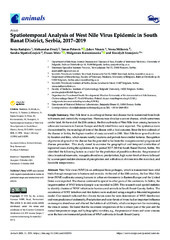Приказ основних података о документу
Spatiotemporal Analysis of West Nile Virus Epidemic in South Banat District, Serbia, 2017-2019
| dc.creator | Radojičić, Sonja | |
| dc.creator | Zivulj, Aleksandar | |
| dc.creator | Petrović, Tamaš | |
| dc.creator | Nišavić, Jakov | |
| dc.creator | Milićević, Vesna | |
| dc.creator | Šipetić-Grujičić, Sandra | |
| dc.creator | Mišić, Dušan | |
| dc.creator | Korzeniowska, Malgorzata | |
| dc.creator | Stanojević, Slavoljub | |
| dc.date.accessioned | 2023-04-19T12:22:35Z | |
| dc.date.available | 2023-04-19T12:22:35Z | |
| dc.date.issued | 2021 | |
| dc.identifier.issn | 2076-2615 | |
| dc.identifier.uri | https://reponivs.nivs.rs/handle/123456789/452 | |
| dc.description.abstract | Simple Summary:& nbsp;West Nile fever is an arthropod-borne viral disease that is transmitted from birds to humans and animals by mosquitoes. Humans may develop a severe disease, which sometimes can be fatal. At the end of the 20th century, the first outbreaks of West Nile fever among humans in urban environments in Eastern Europe and the United States were reported. The epidemics were characterized by the neurological form of the disease with a fatal outcome. Since the first outbreak of the disease in Serbia, the highest number of cases occurred in 2018. West Nile fever spread is driven by location and time, which means nearby locations and periods have similar features. Recognition of patterns of spread of the disease has the potential to facilitate the mosquito control program and disease prevention. This study aimed to examine the geographical and temporal similarities of registered cases during the epidemics in the period 2017-2019 in South Banat District, Serbia. We identified the following factors as crucial for the prediction of possible outbreaks: the presence of virus in natural reservoirs, mosquito abundance; precipitation, high water level of rivers followed by a consequent sudden decrease of precipitation and withdrawal of rivers into the main bed, and favorable temperatures. LT /p> LT br> LT /p> West Nile virus (WNV) is an arthropod-born pathogen, which is transmitted from wild birds through mosquitoes to humans and animals. At the end of the 20th century, the first West Nile fever (WNF) outbreaks among humans in urban environments in Eastern Europe and the United States were reported. The disease continued to spread to other parts of the continents. In Serbia, the largest number of WNV-infected people was recorded in 2018. This research used spatial statistics to identify clusters of WNV infection in humans and animals in South Banat County, Serbia. The occurrence of WNV infection and risk factors were analyzed using a negative binomial regression model. Our research indicated that climatic factors were the main determinant of WNV distribution and were predictors of endemicity. Precipitation and water levels of rivers had an important influence on mosquito abundance and affected the habitats of wild birds, which are important for maintaining the virus in nature. We found that the maximum temperature of the warmest part of the year and the annual temperature range; and hydrographic variables, e.g., the presence of rivers and water streams were the best environmental predictors of WNF outbreaks in South Banat County. LT /p> | en |
| dc.publisher | MDPI, Basel | |
| dc.relation | info:eu-repo/grantAgreement/MESTD/inst-2020/200143/RS// | |
| dc.relation | info:eu-repo/grantAgreement/MESTD/inst-2020/200031/RS// | |
| dc.rights | openAccess | |
| dc.rights.uri | https://creativecommons.org/licenses/by/4.0/ | |
| dc.source | Animals | |
| dc.subject | West Nile virus | en |
| dc.subject | spatial analysis | en |
| dc.subject | sentinel animals | en |
| dc.subject | mosquitoes | en |
| dc.subject | GIS | en |
| dc.title | Spatiotemporal Analysis of West Nile Virus Epidemic in South Banat District, Serbia, 2017-2019 | en |
| dc.type | article | |
| dc.rights.license | BY | |
| dc.citation.issue | 10 | |
| dc.citation.other | 11(10): - | |
| dc.citation.rank | M21 | |
| dc.citation.volume | 11 | |
| dc.identifier.doi | 10.3390/ani11102951 | |
| dc.identifier.fulltext | http://reponivs.nivs.rs/bitstream/id/305/449.pdf | |
| dc.identifier.pmid | 34679972 | |
| dc.identifier.rcub | conv_575 | |
| dc.identifier.scopus | 2-s2.0-85116909119 | |
| dc.identifier.wos | 000716730800001 | |
| dc.type.version | publishedVersion |

